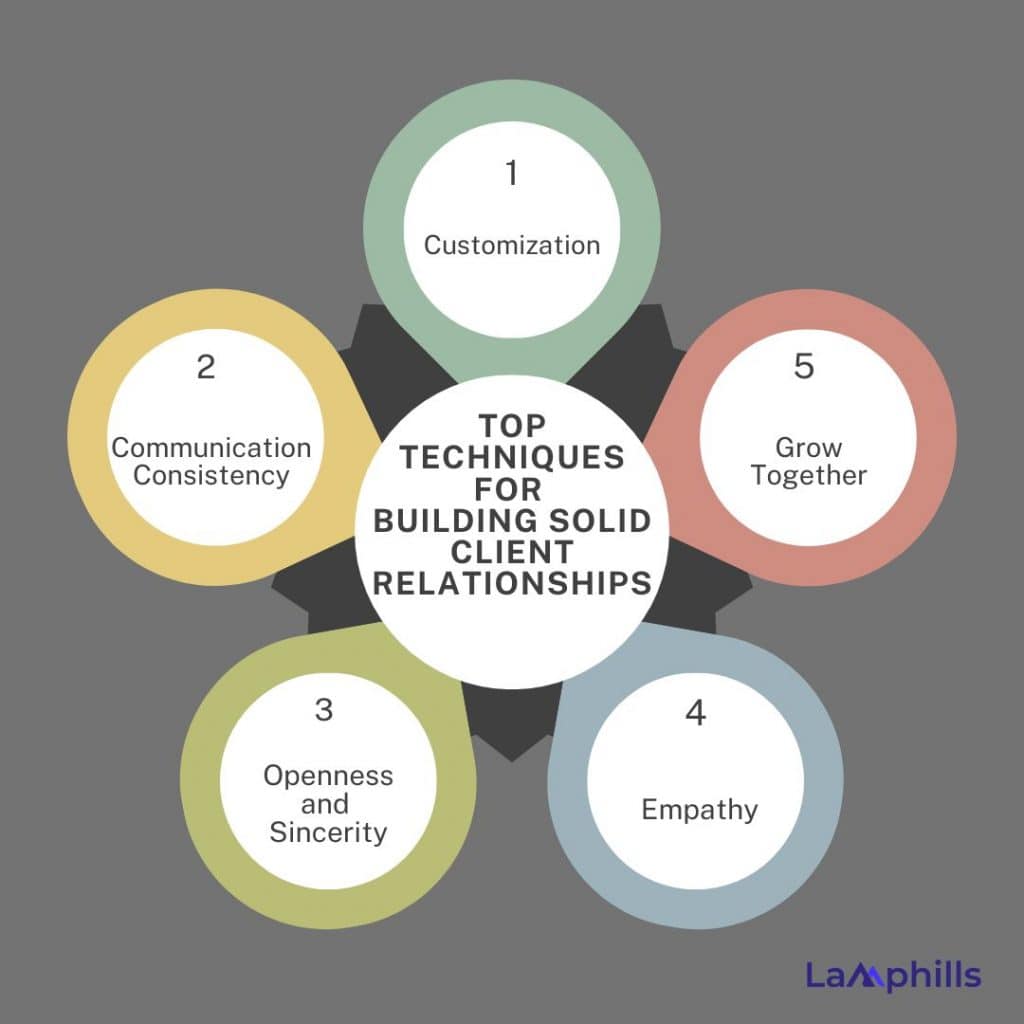Relationships with your clients let you see how they are related. Client relationships can also be used to set up sharing privileges between client accounts. This enables you to prove that a pair shares payment options or membership advantages, or that one customer pays for the goods and services that another client utilizes. Over the years, I’ve faced many obstacles, made mistakes, and developed a profound understanding of what it takes to build enduring relationships. To achieve long-term success, I will discuss my own experience building client relationships as a manager in this article, starting from scratch, and the tactics that have worked best for me.
Key Points
- A client relationship is a continuous relationship that exists between a company and its customers, intending to provide value and uphold confidence.
- Client relationships can be classified as transactional, collaborative, advisory, or supporting, with each form having a different level of depth and sustained involvement.
- Dependability, openness, and a sincere interest in the customer’s success serve as the cornerstones of trust, which is essential to client relationships.
- Collaboration, mutual respect, and open communication are the foundations of a successful client relationship, which breeds loyalty and trust.
- Strong client connections are crucial because they encourage referrals, repeat business, and long-term expansion.
Understanding Client Relationships
I assumed managing customer connections would be quite simple when I first started. Also, I had no idea that maintaining good client connections required more than simply returning calls and meeting deadlines. I learned a lot about building trust, loyalty, and enduring relationships during my time working as a client relations manager.
Understanding each client’s particular demands is the cornerstone of a solid connection, which was one of the first things I ever learned. I was assigned to oversee a small but difficult client early in my career. Although they weren’t the most lucrative customer, they did have certain wants and high standards. I used a uniform approach at first, thinking that what worked for other clients would work for them as well. However, I saw right away that this strategy wasn’t working.
I spoke with the client for a longer period, getting specific questions about their objectives, business, and the difficulties they were encountering. I started adjusting my strategy to suit their requirements by providing more regular updates and individualized fixes. This additional effort had a big impact. Gaining a deeper understanding of their business allowed me to offer value in unexpected ways, strengthening our bond and fostering trust.
Also Read: How to Leverage Client Testimonials for Stronger Customer Relationships
Client Relationships Manager
The foundation of my success as a client relationships manager has always been establishing solid client relationships. When I started the position, I assumed it was just about keeping lines of communication open and making sure projects were completed on schedule. The truth, however, was much more complex. Developing long-term relationships with customers required more than just meeting deadlines; it also required empathy, trust, openness, and a dedication to mutual development, as I soon discovered.
Keeping customers satisfied is just one aspect of being a client relations manager. Building enduring relationships based on mutual success, trust, and understanding is the goal. In addition to helping me advance professionally, I’ve discovered that the connections I’ve made have helped my clients’ businesses develop significantly.
My primary responsibility as a client relations manager is to establish and preserve deep, meaningful relationships with clients. Understanding each client’s needs, attending to their issues, and developing into a reliable collaborator in their achievement are more important than merely managing chores. Strong communication, adaptability, and empathy have been crucial. I’ve turned clients into long-term partners by keeping lines of communication open and providing answers, fostering partnerships founded on mutual success and trust. The primary duties of a client relationships manager include the following:
#1. Building Relationships
My main objective is to establish a personal and professional connection with my clients, learn about their objectives, and customize solutions to suit their requirements.
#2. Managing Expectations
It’s critical to communicate clearly. I make sure to set reasonable expectations and keep clients updated at every stage to prevent miscommunications.
#3. Resolving Issues
Being proactive and anticipating problems has enabled me to handle them before they become more serious. Clients appreciate this level of attention.
#4. Tailored Solutions
Every customer is unique. I invest the time to understand their company and provide tailored solutions that complement their unique goals.
#5. Building Durable Alliances
Delivering consistent value is my main goal, transforming brief interactions into enduring, reliable partnerships.
Building Client Relationships
The benefits of cultivating client connections outweigh the long-term costs. Relationships organically develop into long-term partnerships when clients feel understood, trust you to deliver, and know you care about their success. One of the most fulfilling parts of my work has been fostering connections with clients, but it hasn’t always been easy. Early on, I discovered that the success of any project or collaboration depends on how strong these relationships are. The following are some tips for building strong client relationships:
#1. Start with Clear Communication
Setting the tone with open and transparent communication is something I make sure to do when I initially interact with a customer. I set expectations right away for both parties: what I need from them to succeed and what they can anticipate from me. This lays a solid basis and prevents future misunderstandings.
#2. Pay attention to the client’s objectives
I constantly try to learn about a client’s objectives beyond the current assignment. What is their overall goal? Do they want to grow sales, improve customer satisfaction, or expand their market? I demonstrate that I care about their long-term success in addition to the current task by coordinating my work with their overarching goals.
#3. Set Your Strategy
I now know that every client is unique. Based on each person’s particular needs and preferences, I modify my approach to see what works for them. Some customers desire regular updates, while others would rather be notified only when required. I have been able to establish stronger ties with each client by tailoring my interactions with them.
#4. Increase Trust by Being Dependable
I’ve found that being dependable is the quickest approach to establishing a solid relationship. Keeping my word is what I strive to do. Over time, gaining the trust of clients has depended on being consistent in managing concerns, providing updates, and delivering reports on time.
#5. Show Sincere Interest
Customers will know when you truly care about their success. I always take the time to inquire about their business outside of our professional responsibilities. In addition to fostering connection, this provides me with information that improves my ability to provide solutions. Expressing curiosity goes a long way, whether it’s through inquiring about their company’s most recent projects or talking about industry trends.
#6. Be Open and Honest, Especially When Faced with Difficulties
Every project has flaws, and occasionally things don’t work out as expected. I’ve discovered that being honest about problems—along with a plan to address them—builds credibility rather than trying to hide them. Clients’ trust in me is strengthened when they witness my openness even in the face of failure.
#7. Offer Value Beyond the Contract
Clients value it when you go far and beyond for them. Providing ideas or insights that go beyond the initial area of employment has helped me build stronger relationships. I make an effort to contribute value in new ways, whether it’s by offering guidance on a relevant topic or offering industry insights that can be useful.
#8. Have patience and be reliable
The development of a solid connection takes time. It requires persistent work and patience. Some of my clients were initially distant, but as I continued to provide and be there for them, our relationship grew stronger. It is crucial to remain dedicated, especially in the face of slow development.
#9. Remain Flexible
Being adaptable has helped me sustain solid connections throughout the years as my clients’ demands have changed. I’ve learned to modify my strategy as my clients change, whether that means adapting to shifting market conditions or new business goals.
#10. Together, celebrate victories.
I always make time to acknowledge and appreciate the accomplishments of my clients, no matter how minor. I demonstrate my interest in their development by recognizing their accomplishments. Additionally, it fortifies the partnership by reminding both parties that the relationship is about shared success rather than just transactions.
Top Techniques for Building Solid Client Relationships
In light of my own experience, the following are the main tactics I’ve created to build enduring, solid client relationships:
#1. Customization
Every customer has different requirements. I was able to offer customized solutions that improved our relationship by taking the time to learn about their objectives and business.
#2. Communication Consistency
Even when there isn’t much to report, providing clients with frequent updates demonstrates dedication and dependability.
#3. Openness and Sincerity
Building trust involves being honest about failures or errors. Customers value honesty, particularly when it is combined with proactive problem-solving.
#4. Empathy
Establishing emotional ties by genuinely caring about a client’s difficulties can turn a business relationship into a reliable collaboration.
#5. Grow Together
Pay attention to both parties’ long-term progress. Relationships become stronger and survive longer when you anticipate your client’s requirements and continue to add value.

The Importance of Client Relationships
For a firm to succeed over the long run, client relationships are essential. Building partnerships that result in long-term progress for both parties is, in my opinion, the goal of investing in client relationships, not merely keeping clients satisfied. The reasons they are so important are as follows:
#1. Loyalty and trust
Loyalty stems directly from trust, which is fostered by strong relations with clients. Clients who have faith in you are more likely to support you through difficulties and carry on doing business with you in the future.
#2. Recommendations and Networking
Contented customers are your greatest ambassadors. Building relationships increases the likelihood that your clients will refer you to others, which may open up new doors and spur business expansion.
#3. Solving Problems
Solid relationships make it easier to deal with problems as they come up. Feeling appreciated and understood makes clients more receptive to working together on solutions.
#4. Repeat Business
Building strong relationships frequently results in repeat business. It is less necessary to continuously acquire new consumers when satisfied customers return for additional services or goods.
#5. A Competitive Advantage
Consumers are more willing to stick with a business if they value relationships above transactions. In businesses where competition is fierce, having solid relationships might be the difference.
#6. A deeper comprehension of needs
Building long-term connections with your clients enables you to gain a deeper understanding of their wants, goals, and issues, which enables you to offer more specialized and efficient solutions.
Also Read: What Does a CRM Manager Do? Key Duties and Best Practices
What is a client relationship?
A client relationship is the bond and continuous communication between a company and its customers. Managing communication, comprehending the demands of the client, offering services or goods, and making sure the client is happy with the entire experience are all part of it. To ensure that the client stays with the company over the long run, the objective is to foster loyalty and trust.
What are the types of client relationships?
Depending on the nature of the encounter, client relationships can change. Among the various kinds of client relationships are the following:
#1. Transactional Relationship
Having little commitment over time, it concentrates on a particular purchase or service.
#2. Collaboration Relationship
It entails intimate collaboration with the client to accomplish shared objectives, frequently in long-term relationships.
#3. Advisory Relationship
The company provides continuing counsel and direction outside of its primary service or product, functioning as a consultant.
#4. Supportive Relationship
After the original transaction, it offers ongoing support to the customer, such as technical help or customer care.
What is the key to client relationships?
Trust is essential to a successful client relationship. Building trust requires regular delivery, honest communication, and a sincere interest in the client’s success. Your clients must believe that you are trustworthy and that you understand and prioritize their demands.
What does a good client relationship look like?
The qualities of open communication, respect for one another, and shared success define a healthy client relationship. Goals are shared by both sides, and a spirit of cooperation and partnership prevails. Customers feel appreciated, their issues are resolved quickly, and they have faith that their requirements will be satisfied. Relationships of this nature encourage loyalty and sustained involvement and frequently result in recommendations and additional growth prospects.
Conclusion
Developing deep, enduring partnerships is more important than simply providing a service when it comes to managing customer relationships. Building solid connections that endure over time requires empathy, openness, and a thorough comprehension of each client’s particular needs, as my own experience has shown me. I’ve been successful in building connections that go beyond quick deals and result in long-term success because of my constant communication, honesty throughout trying times, and dedication to mutual development. In the end, trust is the foundation of the strongest client relationships, and it can only be gained with sincere concern, individual care, and a common goal for success.
Related Articles
- Streamline Your Client Onboarding Process: Best Practices for Success
- 9 Reputation Management Red Flags That Scream
- How to Manage Social Media for Your Company: A Guide for Businesses
- How to Build Your Brand from Scratch: A Detailed Guide for Nigerians
- Top Skills Every Advertising Manager Needs to Succeed






